14 email marketing strategy guidelines (2024)
Best email marketing strategy plan for B2B and B2C. Learn planning and tactics that will make your inbound marketing a highly effective growth engine.

Creating a solid email marketing strategy plan can be difficult since there are so many small details that must be taken care into consideration in order to have a successful email marketing strategy.
To make your life easier, we have compiled a list of tactics to help you create highly effective email marketing campaigns.
Keep reading for the best email marketing strategy.
Let’s kickstart with strategy #1!
1. Set up feasible goals and objectives
You need to define your business’s email goals before creating an email marketing campaign. Do not rely on hit and trial methods. Work consistently towards understanding your business’s needs and your customer’s requirements. Here are a few aspects that you should keep in mind:
Start by analyzing who your target customer base is. Find out what kind of products and services they want. Think about how you can provide solutions to their problems. You can make use of a questionnaire or survey to understand your customer’s needs.
The next step is finding out what you want your customers to do with your email. Of course, you want them to take action. But, you need to be precise in your approach. Do you want them to download an e-book or signup for your online course, opt-in for your newsletter? Remember, every email should have a clear and to-the-point goal that reflects in your call to action (CTA).
See how Los Angeles Times tells its subscribers how they can receive the latest Hollywood news by asking them to signup for its newsletter “The Wide Shot”.
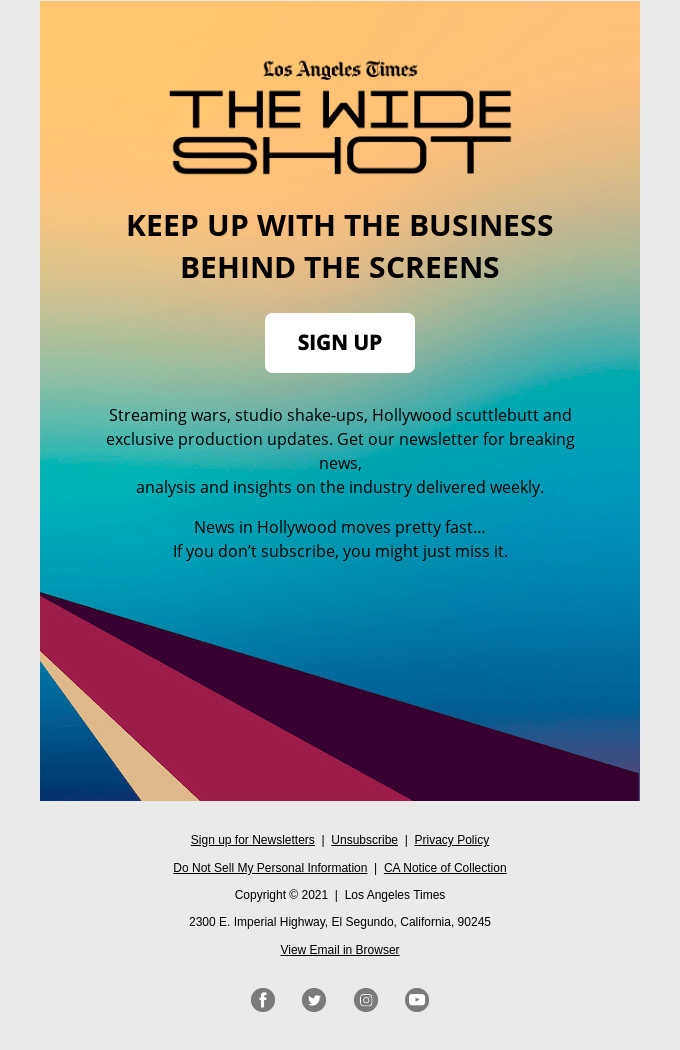
Further, you need to know what kind of content your customers will find relevant. While a buyer in the awareness stage will like detailed information about your product, a customer in the decision stage might prefer a discount coupon.
You can take some inspiration from this discount email from Homage and compel a buyer in the decision stage to make a purchase.

The final step is to understand what kind of results you want from your email campaign. Do you want to generate quality leads? Are you looking to accelerate your sales? Remember, whatever your goal is, make sure to align it with your email marketing strategy.
You also need to keep track of the devices your customer base is using. Are they browsing your website through a laptop? Are they using a tablet or smartphone for opening your emails? Once you know this, make sure you optimize your emails for all the devices.
2. Build an email list of relevant prospects
How do you ensure your email reaches the right people and does not land in the spam folder? By building an organic email list. After all, you can run a successful email campaign only when you connect with people who are genuinely interested in your business.
But, would people give you their email address? Yes, they would if you provided them with an incentive such as free trials or resources. MailNinja does a great job in its signup email by offering a free email marketing content calendar to its prospective subscribers.
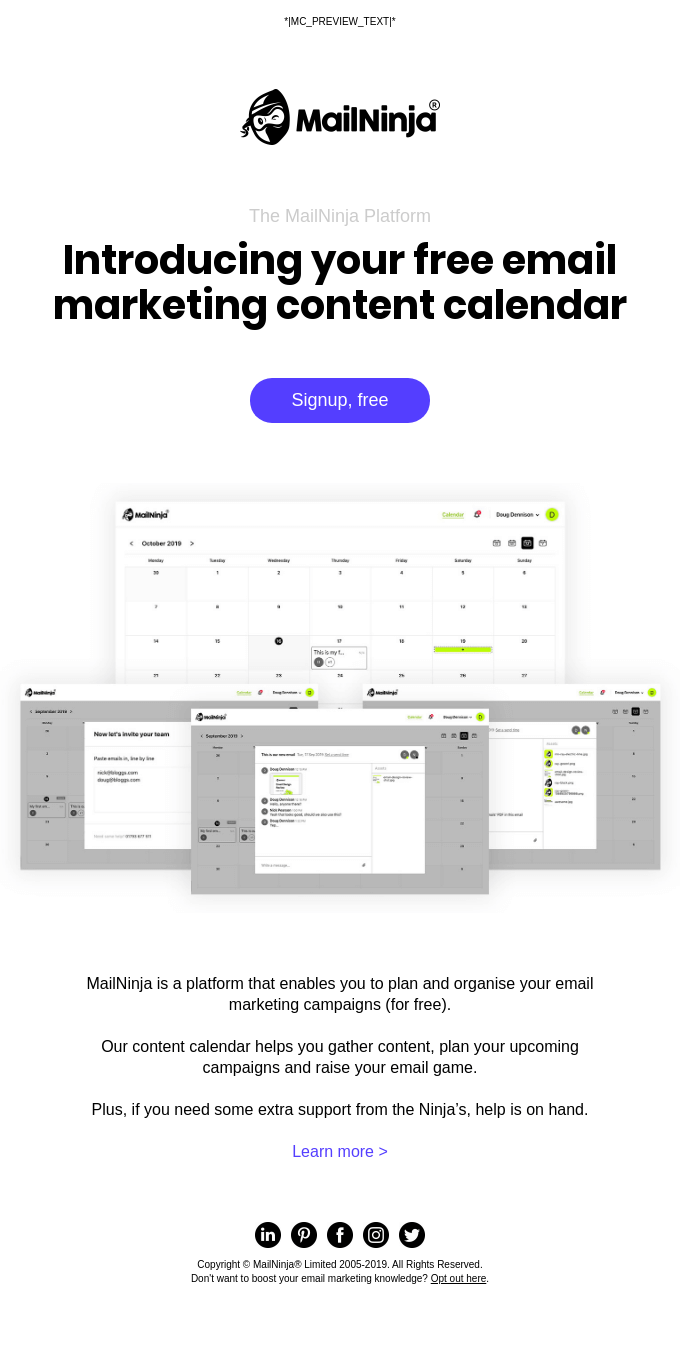
3. Segment your email list to better target your messaging
Do you know segmented email campaigns have an open rate of 94% along with a click-through rate of 38%? That’s huge because non-segmented campaigns have an open rate as low as 42%, along with a click-through rate of 4.5%.
In fact, with proper segmentation, you can also send targeted and relevant cold emails to your prospects which could help with the onboarding experience. If you are struggling to write and understand what information to include in the email, check out this helpful cold email outreach article that has copy and paste templates you can use.
So, you see how segmenting your email list can improve your email marketing campaign.
Segment your subscriber base on the following criteria:
- Age
- Gender
- Demographic
- Locale
- Sales funnel position
- Average income
- Buying behavior
- Browsing history
- Past purchase history
Once you have done the necessary segmentation, you can send your customers relevant emails tailored for them. For instance, if you have a travel agency, you can check the demography of the people in your email list and send them relevant weekend getaways emails.
Have subscribers from New York? No use sending them a weekend getaway email for New York. Instead, send them a weekend getaway email where they can travel to Chicago.
Another great example of email segmentation is from Grammarly. They have used the subscriber’s usage statistics to segment the email. Take a look:
This email is providing valuable information to the user. It is an excellent way of keeping the users hooked to the platform.
4. Personalize your emails to improve customer experience
Email is one of the leading channels for personalization. Do you know 64% of U.S marketers believe that personalization helps them improve customer experience to a great extent?
No wonder 33% of U.S marketers spend half of their marketing funds on personalization!
So, if you haven’t already incorporated personalization into your email strategy, it is high time you do it. Here’s how you can do it:
No wonder 33% of U.S marketers spend half of their marketing funds on personalization!
So, if you haven’t already incorporated personalization into your email strategy, it is high time you do it.
How to personalize your emails:
Always use your customer’s first name while sending an email. Either incorporate the name in your subject line or in the email copy. Do it the way Resy does:
Benefits of email personalization:
- The brand mentioned the first name of the subscriber in the email copy.
- It took into account the behavioral pattern of the subscriber and sent him a detailed report about his dining history.
As discussed above, segmenting your email list will give you a precise idea about your customer’s interests, purchase, and buying history. This, in turn, will help you personalize your email better.

Here’s another email personalization example from Bulb Energy. See how the brand leveraged the electricity consumption pattern of the subscriber to send them a hyper-personalized report:

Create an effective email design?
A good email design should look visually appealing. It should entice subscribers to click through your email. Here are some of the aspects to keep in mind while designing your marketing email:
- Always create high-quality and relevant content.
- Make sure you use white spaces in abundance.
- Try using email safe fonts such as Arial and Century Gothic.
- The images you include should be high-resolution. Every image should have an ALT text.
Incorporate animations, GIFs, and videos in your email. But, don’t include it for the sake of enhancing your email’s look. Ensure your interactive elements make sense in your email.
5. Update your email list regularly
If the inactive subscribers don’t engage with your re-engagement email, remove them. Also, if people have actively unsubscribed from your emails, you must delete them from your email list.
Cleaning your email list will keep your spam complaints low and improve your click-through and conversion rates.
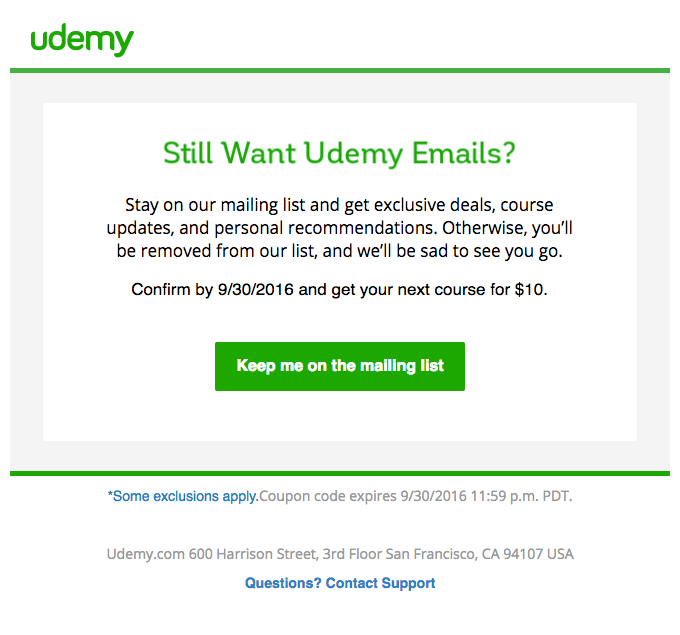
If the inactive subscribers don’t engage with your re-engagement email, remove them. Also, if people have actively unsubscribed from your emails, you must delete them from your email list.
Cleaning your email list will keep your spam complaints low and improve your click-through and conversion rates.
6. Verify your leads
Lead verification is particularly important for B2B businesses. After all, B2B businesses’ main aim is to accelerate their sales, it can be through email, LinkedIn lead generation paid ads or any other form. This can happen only when your prospects are genuinely interested in your product or service.
In short, putting your email marketing efforts in converting quality leads will ensure that your business is always high on cash flow and revenues. You can verify your leads through a variety of lead verification tools such as Optinmonster.
7. Create killer subject lines
Email Subject lines are a great way of grabbing the attention of your subscribers. In other words, your subject line should compel people to open your email. How can you do that?
1. Personalize it
See how Medium uses the subscriber’s name to give a personal touch to its subject line:

2. Keep it short yet descriptive
The above-mentioned subject line is short yet shows what the whole email is all about. Here’s the email from Medium with the above-mentioned subject line.

3. Limit the use of punctuations
The use of excessive punctuation can make your email appear like spam. See how Medium has used single punctuation in its subject line above.
4. Include emojis
Emojis in subject lines can work wonders in conveying emotions and saving space. No wonder 56% of brands using emojis have a higher open rate!
Here’s how Campaign Monitor makes good use of emojis in its subject line.
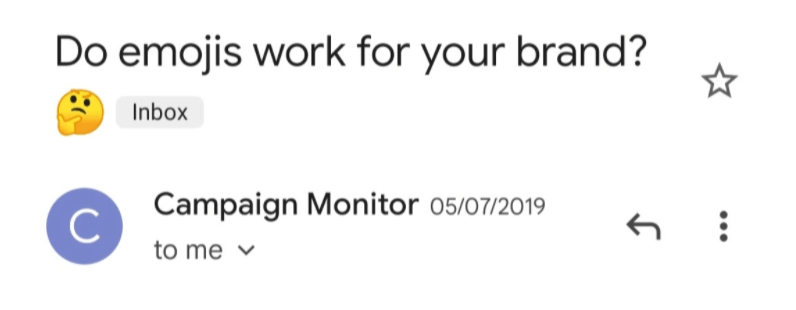
A relevant email copy follows the subject line:

8. Draft a winning email copy
A compelling email copy accounts for 26% of open rates for 45% of small businesses. Therefore, make sure you create a stellar email copy. As mentioned already, start by drafting an impeccable subject line. Also, make sure your subject line aligns with your email copy. See how Uncommon Goods strikes a chord with its subscribers through its holiday email subject line, which reads:

Also, their Uncommon Goods email copy is in perfect sync with the subject line:

Also, their email copy is in perfect sync with the subject line:
Further, make it a point to keep the content relevant for the subscribers. Tell the subscribers why you are emailing them.
See how Postable keeps their email copy precise, simple, and on point. The emails make the message that they are offering a 20% discount on the fathers day card loud and clear in the first line. Besides, the email contains an actionable CTA of “browse cards.”
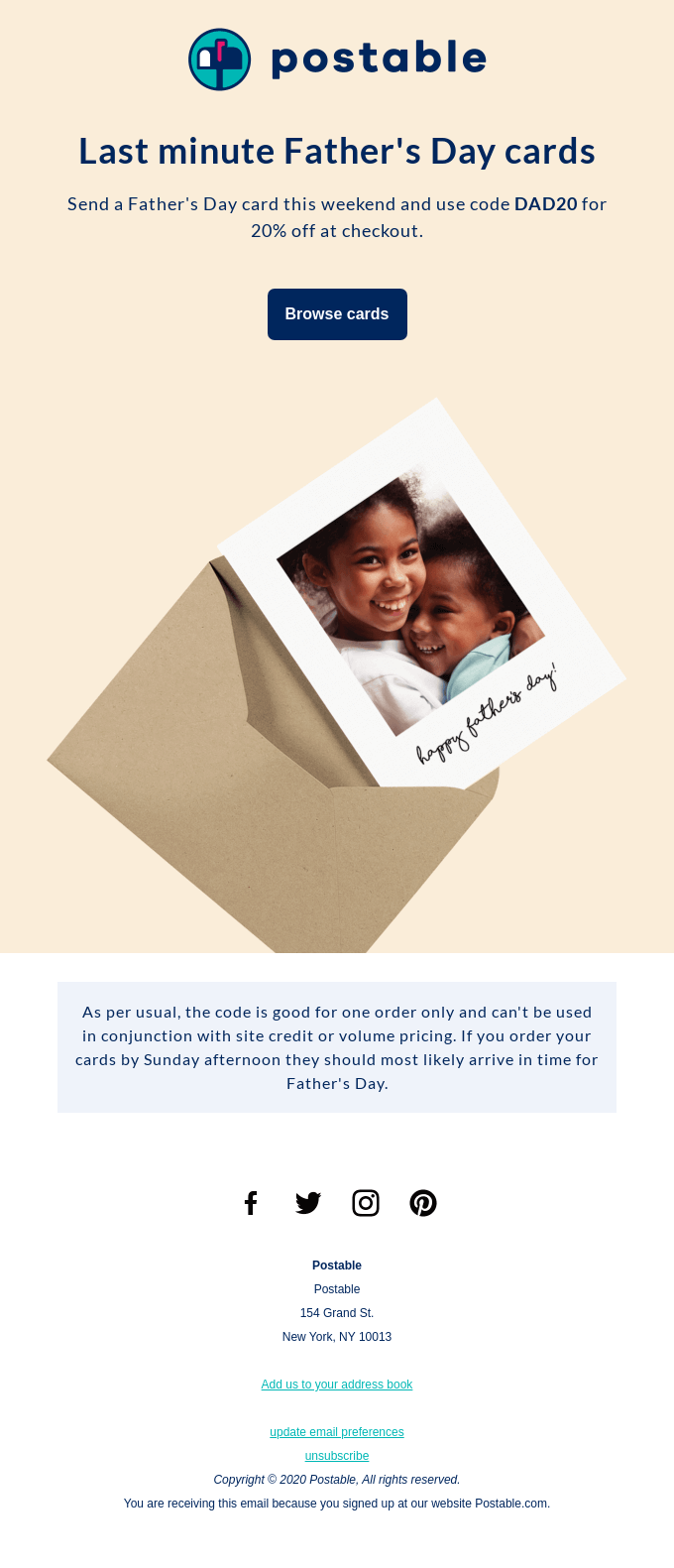
And, always remember to draft your email copy in the second person. Simply put, when you draft the email copy with pronouns such as you, your, you are directing the copy towards your subscribers.
Further, you need to provide value to your customers through email copy. Instead of talking about your products or service’s features, let them know how it can benefit them.
Do it the way Headspace does. In the first line, they make it clear that they want to know about the topic you would like to hear in their next live group meditation. They are also quick in adding that the group meditation will help the subscribers relax their minds.

9. Find the right email sending time
Imagine creating a top-notch email marketing campaign. From email copy and subject lines to relevant offers and discounts, you ensure your email campaign has all the elements to make it a hit amidst your subscribers.
However, your email marketing strategy will be successful only if people open and click-through it. That’s why you should send the right email at the right time.
So, what’s the best time to send an email? According to Coschedule, you should send your marketing emails on Tuesday, Wednesday, and Thursday
While Tuesdays can give you the highest click-through and open rates, Wednesday and Thursday also make a good day for sending emails.
Further, CoSchedule suggests that you should send your email between 9 am and 11 am. Since people are mostly in the office around this time, their probability of checking their inbox increases.
How frequently should you send marketing emails to your subscribers?
The first step is to create your brand’s impact in the customer’s mind. So, start by sending a welcome email to establish a connection with your subscriber base. Further, you can send newsletters with relevant information that resonates with your customer base.
Once you see that customers are engaging with your email, try sending them a discount and offer emails. It will help you increase conversion. However, make sure you don’t send more than three promotional emails. Simply put, avoid sounding desperate for a sale.
In short, send a maximum of four relevant emails to your subscribers to avoid landing in their spam folder.
10. Include interactive elements
People receive 126 business emails every day. So, how can you make your email stand out amidst such a huge inbox crowd? By incorporating interactive elements in your email. After all, 91% of consumers look forward to interactive emails in the form of GIFs, carousels, cinematographs, embedded videos, and gamification.
Interactive emails aren’t only engaging but have the potential of increasing conversions too, you can also provide more value to your audience by selling digital downloads for free to help you with engagement and leads. In other words, rather than talking about your product and services, an interactive element lets you show it to your customers. Whether it’s a new product launch or an updated feature in your service, interactivity lets you highlight it creatively.
Take a look at this interactive email from Uncommon Goods. See how the brand has seamlessly incorporated cinematographs in its email to promote its Indoor S’ More fire pit. The cinema graph didn’t only enhance the visual appeal of the email but also worked as a demonstration of the fire pit. Now, that’s cool!
Further, if you run an eCommerce business, you can take some inspiration from the brand Saks Fifth Avenue. See how it is promoting its floral dress through a beautiful cinema graph.
Another excellent example of using interactivity comes from Hollister. The brand plays with its hero image to entice its customers to make a purchase.
11. Work on mobile optimization of emails
Mobile email accounts for 43% of the email opens. Therefore, if you aren’t optimizing your emails for mobiles, you might lose a huge chunk of your subscribers. Here’s how you can create mobile-friendly emails:The mobile version of an email displays only 25 characters of a subject line.
So, keep the subject line short.
- Use preheader text as a preview of your email copy. It will give mobile users a quick idea about your email content. This is how a preheader text looks like on mobile
- Keep your email copy precise.
- Place your CTA at the top to improve your email’s click-through rate.
Do it the way Godiva does. The brand has created a mobile-optimized email and placed its CTA at the top with an enticing free shipping message.
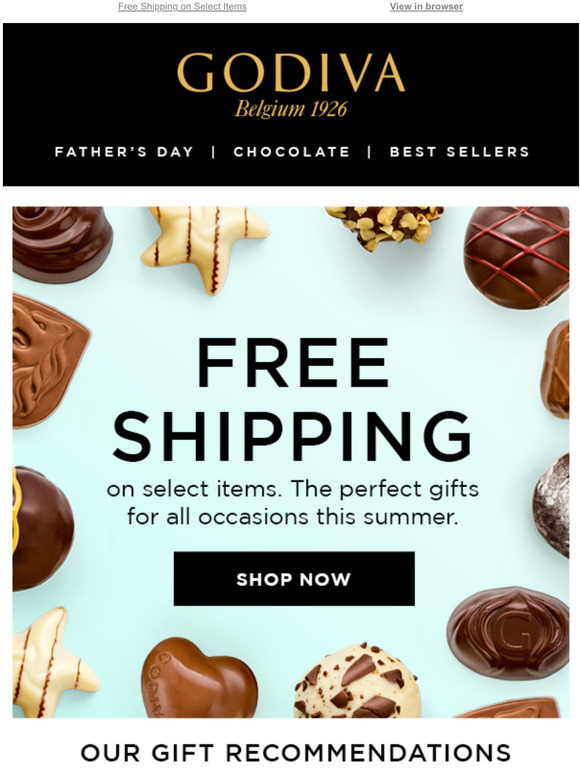
12. Use email automation
Email automation is the third most used strategy that businesses incorporate in their email marketing campaign. After all, it takes a lot of work off of the marketer’s shoulder. Whether it is a welcome email for a new subscriber or a cart abandonment email for retaining a customer, email automation takes care of everything.
So, start automating your emails right away and use the time you save in enhancing your business’s core competencies.
Here’s an example of an automated welcome email from Guru. The brand makes sure to give the new subscriber a seamless onboarding experience. It takes the customer through a step-by-step process of using Guru. Brownie points for :
- Name personalization
- Proper use of whitespace
- Relevant graphics

Another excellent example of an automated email is the following cart abandonment email from Rooted. The brand makes use of:
- Short and quirky copy
- A compelling image of the abandoned product
- A clear CTA

13. Always A/B test your emails
A/B tests allow you to analyze two variations of the same email. From your subject line to the email copy, you can A/B test every aspect of your email.
You can send the two different versions of your email to two subgroups of subscribers and analyze the results. The analysis will help you understand which version of the email is performing better. This, in turn, will help you implement the best version of your email marketing campaign. It definitely will ensure a sure shot to your email marketing success and accelerate your revenue. After all, leveraging A/B testing increases a firm’s revenue by 37% compared to those who don’t implement A/B testing in their business.
14. How to monitor, analyze, and optimize your email marketing strategy?
Your real work begins when you are done creating and implementing your email marketing campaign. You need to ensure that your campaign keeps performing well consistently.
You can keep your email marketing campaign top-notch by analyzing the key email metrics such as open rate, click-through rate, return on investment, and more.
An insight into these key performance indicators can help you gauge the performance of your email marketing campaign. If you see a particular metric not doing well, you can take corrective measures to improve it.
For instance, if you see your cart abandonment rates soaring, you might want to reinvent your re-engagement strategy.
Now, let’s take a look at the various techniques that can help you understand your email marketing performance.
Customer Life-Time Value (CLTV)
The CLTV model focuses on customer engagement to improve your email marketing performance. The more a customer interacts with your brand, the higher will be their CLTV.
CLTV gives you an idea about the total profit you are making through a single customer. This, in turn, will give you a precise idea about your high-value customers, thereby helping you target them in a better way.
For instance, if a customer is purchasing more from your business, provide them with incentives in the form of gift cards, coupon codes, and discounts. It wouldn’t only increase their loyalty towards your brand, but will also encourage them to buy more from you.
Industry research
Market research can play a vital role in helping you gauge your email marketing performance. Take the help of surveys, questionnaires, and focus groups to ask your industry how useful they found your campaign.
Feedback
It is important to take feedback from your employees, sales team, and vendors. After all, they are the ones directly working with your customer base. You can ask them the following questions:
- Are your customers satisfied with your campaign?
- Is your market niche expanding?
- How are the competitors reacting to the campaign?
Wrap Up
With the tips, tools, and strategies mentioned above, you can easily create a winning email marketing strategy.
Start by understanding your business’s needs. You also need to create an email list with proper segmentation. Make sure you clean up your email list at regular intervals.
Sending targeted and hyper-personalized emails is also critical for the success of your email marketing plan. Further, you should keep your subject line and email copy relevant and precise.
You can include dynamic content in your emails to make them appealing. Also, you can use email automation and ensure you send the right email at the right time.
You should also make your emails mobile-friendly and analyze the KPIs minutely. Also, never forget to A/B test your emails.
All in all, give your customers such an email marketing experience that will help your business thrive, one email at a time.

